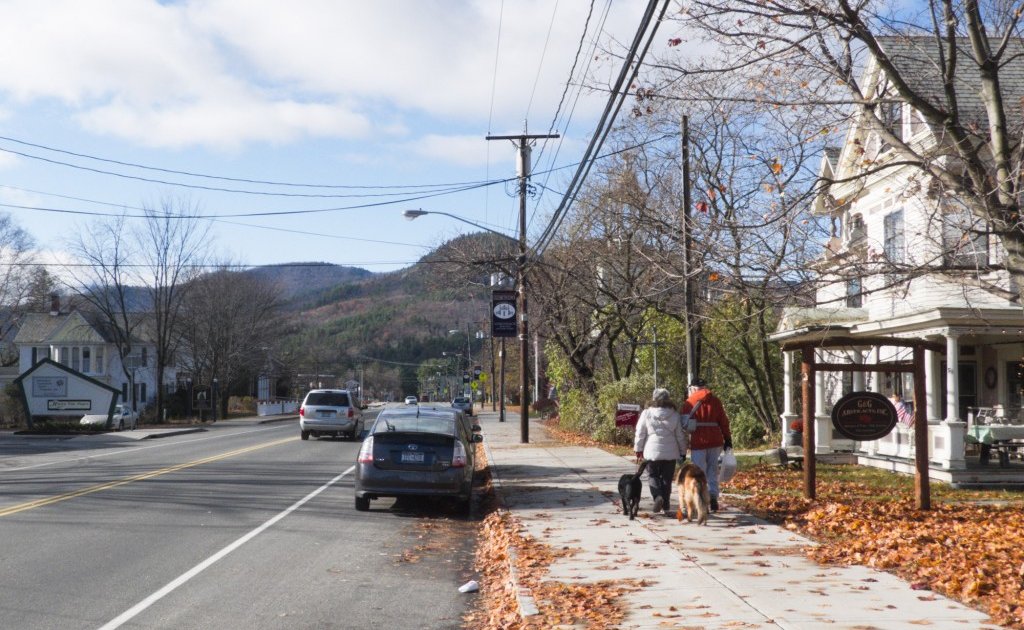
With aging populations, above-average obesity rates, and limited public transportation options, rural areas are starting to look at street policy as a key way to get citizens moving again—and it is often health organizations, not transportation experts, that are taking the lead. In New York’s Adirondack Park, the Essex County Public Health Department has teamed up with Rural Action Now! to build momentum and awareness of the importance of safe and accessible streets. Their recent win in the Essex County seat, Elizabethtown, which unanimously passed a Complete Streets policy in October, shows that momentum is building.
That local policymakers are taking control of this issue is particularly significant in this region, given historic battles over land use in the Park. By being proactive, advocates have been able to reposition complete streets as a local issue, and not an outside mandate.
Who Are The Roads For?
The Adirondack Park has a long and contentious history rooted in the struggle for power; in a state that prides itself on home rule, the Adirondacks has been a unique exception. Originally established by state legislation in 1885, this 6.1 million-acre state park, where more than half the land is privately owned, has largely been controlled by outside forces—environmentalists eager to preserve the area’s natural resources, and Albany politicians wary of local control. Not surprisingly, the culture clash between locals and non-locals can be palpable. For example, when Gov. Nelson Rockefeller established the Adirondack Park Agency (APA) in 1971 to implement state oversight for planning in the region, residents threatened to secede from the state. Private developers in Adirondack towns now go through three levels of governmental review—town, county, and the Park Agency, which assures that the development’s plans are aligned with the Master Plan for the Park.

So “fiats” perceived to come from Albany rarely receive a warm reception. According to Josh Wilson, Program Manager for Rural Action Now!, when Albany’s Complete Streets bill was winding its way through the legislature this spring, local highway superintendents had plenty of concerns and made them known.
Elizabethtown is only a few miles from the Adirondack Northway, in the heart of “high peaks” tourist country. So when health advocates started talking about making roads more bike and pedestrian-friendly, they faced another obstacle: Some local grumbling that tax dollars shouldn’t be used to accommodate Lycra-clad visitors. The Lake Placid Ironman Triathalon is the largest 1-day event in the region and brings in 2,000 competitors, 4,000 volunteers and $8 million in economic impact for Essex County. But it also brings “outsiders,” some of whom disobey road laws and fling water bottles and debris on private property.
Embracing Control, Locally
The new Elizabethtown Complete Streets resolution will apply to town-owned roads, but in order to assure coordination in the road network, the county needs to be on board as well. Advocates have worked to surmount both the reticence of the highway superintendents and the perception that complete streets is for outsiders.
After forming the Essex County Complete Streets Coalition (ECCSC) in April, advocates convened at a workshop in June featuring Complete Streets advocate Justin Booth. Soon thereafter, Wilson and Jessica Darney-Buehler (of Essex County Public Health) had a successful meeting with the Essex County Highway Superintendents Association, which includes the county’s Department of Public Works manager and the 18 town highway superintendents responsible for roads throughout the county. Association representatives subsequently agreed to join a complete streets working group with elected officials and advocates. The working group is now looking at categorizing roads according to traffic count, land use and population density in order to determine what improvements make sense on the various types of roads.
One of the questions raised by the superintendents concerned the fact that the proposed state legislation described complete streets “best practices” without clearly defining who will develop them. In a further attempt to tackle the issue locally, The Heart Network and Rural Action Now! released a “Complete Streets Advocacy Toolkit for North Country Communities” that included Design Guidance for the types of roads common in rural areas like the Adirondacks.
Wilson and Darney-Buehler plan to reach out to businesses, who understand the benefit of flowing tourist dollars, and ask them to help build local support. Ahead of the next Iron Man Triathlon, they plan to ask local bike shops to stress to competitors the importance of following the rules.
And they’ve been working to raise awareness that safer roads that encourage healthy communities are not just for outsiders. According to an ECCSC brochure, 61% of Essex County adults are overweight or obese. Eighty-one percent of county residents who answered a recent survey felt that childhood obesity was a problem in their community. Referring to the role local advocates have played in framing the debate, Wilson told MTR that “the highway supers seem psyched that they don’t have to address these issues on their own. We’re starting small, and trying to build a model for the region.”
Images: Top – Nadine Lemmon/TSTC; Bottom – edited Wikimedia Commons image.

[…] This post was mentioned on Twitter by Complete Streets, NRC Transportation and Streetsblog Network, Alexandria. Alexandria said: In NY's Adirondacks, Winning Hearts and Minds for Complete Streets: In New York's Adirondack Park, the Essex Cou… http://bit.ly/hHqb9V […]
[…] Streets policies are gaining adherents in rural communities in upstate New York, according to Mobilizing the Region. Biking in L.A. ponders the legal environment that allows a motorist who kills a cyclist to walk […]
[…] residents of upstate New York’s Adirondacks are on board with completing the streets. (Tri-State Campaign Blog) Filed under: Campaign Blog […]
[…] and Brookhaven; a health-focused approach in Kingston; and a locally oriented strategy in Elizabethtown to win passage of complete streets policies in all five […]
[…] New York’s transportation system, now and in the future. Communities across the state have taken the step, Governor Cuomo has expressed support for the legislation, and now is the time for the Senate […]